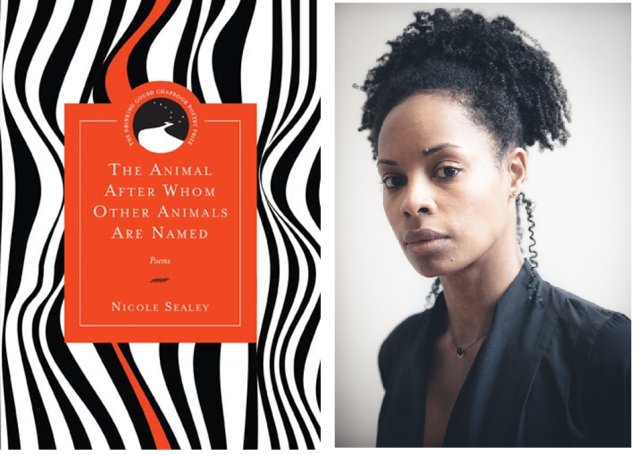“Not having a process, I’ve learned, is perhaps my process.”

The Animal After Whom Other Animals Are Named (Northwestern University Press, 2016)
Does the chapbook form have an impact on the politics of the poems that appear inside it?
Not at all. In my case, the poems came/ come first. The packaging that binds them is secondary.
What obsessions led you to write your chapbook?
I’m obsessed with the human condition—I’m a stereotypical poet in that way.
What’s your chapbook about?
This is a difficult question to answer because the work isn’t based on a specific project. There are poems that speak to each other like the Legendary sonnet series based on those featured in Paris Is Burning, a documentary film about drag pageants in 1980s Harlem, and the “Clue” sestinas and the erasure of those sestinas that follow. Otherwise, The Animal is all over the place, which is how my mind works.
What’s the oldest piece in your chapbook? Or can you name one poem that catalyzed or inspired the rest of the chapbook? What do you remember about writing it?
There isn’t a specific poem that catalyzed or inspired the chapbook as a whole. Again, I have poems that might speak to each other, but even those began with an idea or image specific to each one. Each is its own thing.
The oldest poem in The Animal is “Unframed.” I wrote it during a 30/30 challenge, in which I attempted to write one poem a day for a month. I failed to write a poem a day, but managed one good poem and a few fairly decent lines.
How did you decide on the arrangement and title of your chapbook?
I didn’t really know what I was doing. What I did know is that, whether in tone, theme or word association, I wanted each poem to bleed into the next. I believe, too, that arranging poems is not unlike writing poems—both processes begin with inspiration and proceed with impulse. In terms of title, I love a long title and that line from “Object Permanence” is one of my best.
Which poem is the “misfit” in your collection and why?
“Clue,” the sestinas based on the board game of the same name, is definitely the misfit of the bunch. The inspiration for it seemed to come out of nowhere. At the same time I was writing “Clue,” I started thinking about the erasure as a poetic form. While I didn’t yet feel quite right erasing other peoples’ text, I had no problem erasing my own. “Clue” then provided the text for “C ue.”
I have since formed my opinion about erasure: the form can be as difficult and time consuming as any other.
What was the final poem you wrote or significantly revised for the chapbook, and how did that affect your sense that the chapbook was complete?
I didn’t write poems for the chapbook. I wrote poems and, later, arranged them in The Animal. “Candelabra with Heads” was one that had significant revisions. I’m actually still tinkering with it, so much so that I’ve written a poem in response to my tinkering. As Leonardo da Vinci said, “Art is never finished, only abandoned.”
Describe your writing practice or process for your chapbook. Do you have a favorite prompt or revision strategy? What is it?
I’ve never had a writing regimen. I am a writer who spends most of my time not writing, which leaves lots of time to think. I write when moved and jot down lines as they come but, in terms of a formal process, I have none. I use to beat myself up about this. But not having a process, I’ve learned, is perhaps my process.
What has the editorial and production experience with the press who picked up your chapbook been like? To what degree did you collaborate on the cover image and design of your chapbook?
I haven’t heard many, but I have heard a few unfortunate stories about presses. I can honestly say that that was not my experience. Northwestern University Press was a dream. They suggested edits, of which I could take or leave, and offered a variety of cover images from which to choose. I couldn’t have asked for a better team.
If you have written more than one chapbook or novella, could you describe each of them in chronological order?
I wish I were this prolific! I have the one chapbook and a full-length on its way!
What are you working on now?
Right now, I’m working on revisions to my debut full-length collection, Ordinary Beast.
What advice would you offer to students interested in creative writing?
Read widely.
*
Born in St. Thomas, U.S.V.I. and raised in Apopka, Florida, Nicole Sealey is the author of Ordinary Beast, forthcoming from Ecco in fall 2017, and The Animal After Whom Other Animals Are Named, winner of the 2015 Drinking Gourd Chapbook Poetry Prize. She is the executive director at Cave Canem Foundation. Author photo by Rachel Eliza Griffiths.
“It’s Not Fitness, It’s A Lifestyle”